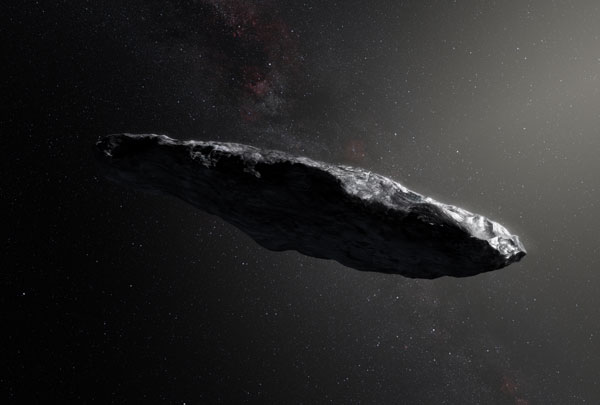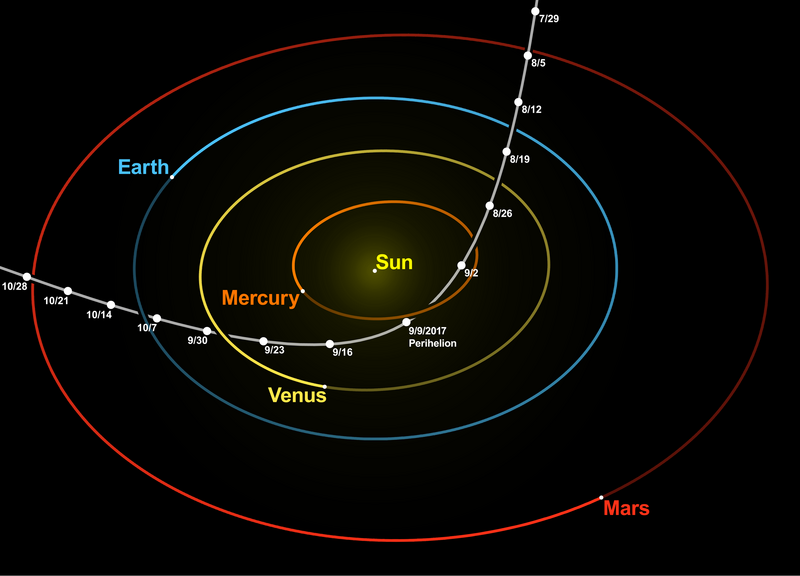[영어공부] 성간물체 '오무와무와'의 기묘한 움직임이 설명 되려나?
EXPLAINING THE ODD BEHAVIOR OF INTERSTELLAR OBJECT 'OUMUAMUA
BY: COLIN STUART, MARCH 22, 2023, Sky and Telescope [Link]
It wasn’t aliens after all — an astrochemist and an astronomer have teamed up to explain why the interstellar object 1I/’Oumuamua behaved the way it did.
외계인의 태양계 방문은 아니다. 천체화학자와 천문학자들이 합세해서 이 기묘하게 생긴 성간물체 '오무와우와'가 왜 그렇게 움직였는지 설명 하려고 한다.
An astrochemist and an astronomer may have just explained the unusual orbit of the interstellar visitor 1I/‘Oumuamua. They propose that it was emitting hydrogen picked up during its time between the stars, offering a relatively simple explanation to a puzzle that has previously prompted some outlandish claims.
천체화학자와 천문학자가 합세해서 성간 떠돌이물체(interstellar visitor) '오무와우와'의 비범했던 궤도를 설명할 수 있게 될지도 모른다. 이 물체가 별 사이를 지나면서 축적한(pick up) 수소를 방출 했을 것이라고 제안했다. 이전의 엉뚱한(outlandish) 주장들을 불러 잃으켰던(prompted) 수수께끼를 불식시킬 만한 명료한(simple) 설명으로 보인다.
The discovery of 'Oumuamua made headlines in 2017 because it was the first object ever observed to have entered our solar system from the wider universe. Its true nature wasn’t immediately obvious. Although initially classified as a comet, it didn’t have a visible tail or coma, as comets do. It was also extremely elongated, resembling a cigar in shape.
2017년에 '오무와무와'의 발견은 세상을 떠들썩하게 했는데(made headlines) 천문관측 이래 광할한 우주에서 우리 태양계로 들어와 처음으로 관측된 물체 였기 때문이었다. 그 정체(nature)가 확실히 발혀지진 않았다. 처음에는 혜성(comet)으로 분류됐으나 혜성이라면 가지고 있어야 할 꼬리(tail)나 핵(coma)을 찾아볼 수 없었다.
One thing that did make it more comet-like was the way it was accelerating as it went away from the Sun. It slowed on its way out, but not in the way expected if only gravity were in play; something was creating a force counter to gravity. Except that the normal mechanism behind such non-gravitational acceleration didn't seem to fit. Comets are home to large quantities of water ice and as the Sun warms this ice, it’s ejected as jets of gas that act as mini-rocket boosters. However, besides the lack of observed coma or tail, 'Oumuamua was also too small to have captured sufficient solar energy to drive this kind of activity.
* '오무와무와'의 미스터리 만큼이나 영문이 조금 꼬여있다.
이 물체가 혜성처럼 보이는 한가지 점은 태양으로부터 멀어질 때의 가속되는 방식이다. 멀어지면서 속도가 떨어지는데, 문제라면 태양의 중력 이외의 힘이 작용하는 것처럼 보인다는 점이다. 그 외에도 중력가속을 따르지 않는 비 정상적인 동작을 하는 듯이 보였다. 혜성은 다량의 얼음을 보유하고 있으면서(home to) 태양의 열기에 녹아 마치 소형 로켓의 추진기 처럼 긴 분출물을 내뿜는다. 하지만 관측된 핵과 꼬리로 보건데 '오무와무와'는 너무 작아서 이런 [비정상적 가속운동]행동을 일으킬 만큼 충분한 태양 에너지를 받을 수 없었다. [링크]
The conundrum led some to call on more unusual explanations, such as the idea that ‘Oumuamua was an alien spacecraft with actual rocket boosters. However, Jennifer Bergner (University of California, Berkeley) and Darryl Seligman (Cornell University) have just put forward a much more straightforward scenario. “We had all these stupid ideas... and it's just the most generic explanation,” Seligman says.
이런 이상한 행동을 설명하려고 추측(conundrum)이 난무했다. 일테면 '오무와무와'는 외계인의 로켓추진체 였다는 설도 있었다. 하지만 버클리소재 캘리포니아 대학의 제니퍼 버그너와 코넬 대학의 대릴 샐리그먼은 좀더 실체적인 설[외계인 설은 황당하다]을 제시한다. "다 바보같은 소리 입니다. 아무말 대잔치 같은거죠." 셀리그만이 말했다.
“A comet traveling through the interstellar medium [gets] cooked by cosmic radiation,” says Bergner. Cosmic rays penetrate tens of meters into the ice, converting up to a quarter of the water molecules (H2O) there into molecular hydrogen (H2). This trapped hydrogen is then released when the Sun warms the comet.
"혜성은 떠돌며 우주복사를 받아 성간물질(interstellar medium)들이 들어붙어 있습니다(get cooked)." 버그너의 말이다. 켜켜히 쌓인 얼음에 우주선(cosmic rays, 별에서 방출된 높은 에너지의 별빛)이 침투하여(penetrate) 네개의 물 분자(H2O)를 한개의 수소분자로 바꿉니다. 그렇게 고여있던(trapped) 수소가 태양열로 혜성을 덮히면 방출되는 겁니다." [전자렌지에 겨란을 삶으면 속이 끓어 겉에서 익어 단단해진 껍질을 뚫고 폭발하는 원리와 같다.]
Bergner and Seligman found that the effect of this outgassing is normally negligible. “But because ‘Oumuamua was so small, we think that it actually produced sufficient force to power this acceleration,” Seligman explains. At the same time, the amount of ice released would have been small enough that astronomers on Earth wouldn’t have seen it. The duo published their findings in Nature.
버그너와 셀리그만은 이런 가스 분출의 효과가 보통의 혜성에서는 무시할 정도라는 것을 알고 있다. "하지만 오무와무와는 크기가 아주 작아서 이 효과의 영향으로 가속될 수 있을 거라고 생각합니다." 라고 셀리그만이 설명했다. 그렇긴 해도(at the same time) 분출되는 얼음의 양이 아주 작아서 지구에서 천문 관측자자들이 이를 관측할 수 없었을 것이라 한다. 두 사람름 이 이론을 네이쳐지에 발표했다.
Alan Fitzsimmons (Queen’s University Belfast), who was not involved in the research, is impressed. “It’s a nice piece of science,” he says. “It probably won’t settle all debate around this object, but it provides a coherent picture of ‘Oumuamua based on current knowledge, without resorting to exotic or even fanciful theories.”
이 연구에 참여하지는 않았지만 벨파스트 대학의 알란 피츠시몬스는 이에 동의한다. "아주 그럴듯한 과학적 설명입니다." 그가 말했다. "이 물체에 대한 논란을 모두 설명하지는 못하지만 현재까지 알려진 바에 근거하여 오무와무와에 대한 괴상하거나 기발함을 배제한(without restoring) 논리적인 설명(coherent picture)이 될 수 있어요."
If Bergner and Seligman are correct, it could help us to better understand the conditions in other solar systems. “The comets and asteroids in the solar system have arguably taught us more about planet formation than what we've learned from the actual planets in the solar system,” Seligman says. “I think that the interstellar comets could arguably tell us more about extrasolar planets than the extrasolar planets we are trying to get measurements of today.”
만일 버그너와 샐리그만의 [주장이] 맞다면 그들의 이론은 우리 태양계의 성립조건(the condition)을 이해하는데 일조할 것이다. "혜성과 소행성들은 우리 태양계 내의 실존하는 행성들에 비교해서 많은 의문점들을 보여줬습니다." [어떻게 행성으로 뭉쳐졌고 어떤 조건으로 소행성이나 혜성들은 행성으로 뭉쳐지지 못했나?] "내 생각에는 행성간 혜성[태양계에 묶이지 않은 떠돌이 혜성들]은 외계 행성[별을 공전하지 않고 홀로 떠도는 행성]들에 대해 현재 우리가 알고있는 것보다 더 많은 의문들을 제시해 줄 것이라고 봅니다."
Fitzsimmons also thinks it could tell us more about our solar system. “This process should occur for small comets from our own Oort Cloud,” he says. “What’s needed is a closer look at small objects on very long period orbits, which may be possible in the coming era of the Rubin Observatory and Extremely Large Telescope.” With both facilities due to see first light in the next five years, we may not have to wait too long for answers.
피츠시몬스는 그 의문들이 우리 태양계를 이해하는데 더 많은 것들을 알려줄 수 있을 거라고 생각한다. "이런 현상[혜성에 켜켜히 쌓인 성간물질들이 분출되는]은 우리 태양계의 우르트 구름에서 작은 혜성들에게도 일어날 겁니다." 그가 말했다. "아주 긴 공전주기를 가진 작은 천체들을 상세히 들여다 보려고 앞으로 완성될 류빈 천문대나 초거대망원경(ELT)가 필요한 거죠." 이들 두 천문대가 향후 5년 내에 첫 관측(first light)을 시작한다. 우리의 의문을 풀기까지 조금만 기다리면 될 것이다.


댓글 없음:
댓글 쓰기